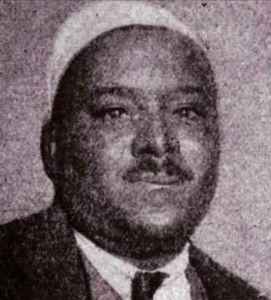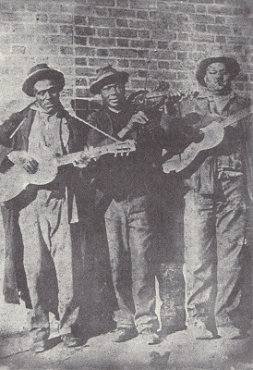Peg Leg Howell facts for kids
Quick facts for kids
Peg Leg Howell
|
|
|---|---|

Advertisement photo for Columbia Records, c. 1926
|
|
| Background information | |
| Birth name | Joshua Barnes Howell |
| Born | March 5, 1888 Eatonton, Georgia, U. S. |
| Died | August 11, 1966 (aged 78) Atlanta, Georgia, U. S. |
| Genres | |
| Occupation(s) |
|
| Instruments |
|
| Years active | 1923 to mid-1930s, 1963 |
| Labels |
|
| Associated acts |
|
Joshua Barnes Howell, better known as Peg Leg Howell, was an American blues singer, songwriter, and guitarist. He was born on March 5, 1888, and passed away on August 11, 1966. He helped connect early country blues with the later 12-bar blues style. Peg Leg Howell was one of the first blues musicians from Atlanta to record music before World War II. He was also one of the first blues artists to make a "race record," which were recordings made by African American artists for African American audiences.
Contents
Peg Leg Howell: A Blues Legend
Early Life and Music
Joshua Barnes Howell was born on March 5, 1888. His family lived on a farm in Eatonton, Georgia. His parents were Thomas Howell and Ruthie Myrick. He grew up surrounded by music. However, he did not start playing seriously until his early twenties. He finished school after the 9th grade. Then, he worked on the farm with his father.
In 1909, when he was 21, he taught himself to play the guitar. He became very good at fingerpicking and slide guitar techniques. He continued working on the farm until 1916. That year, he was shot during an argument with his brother-in-law. This injury caused him to lose his right leg. After that, he had to wear a special artificial leg.
Because of his injury, Howell stopped working on the farm. He found a job at a fertilizer plant in Madison County, Georgia. He worked there for one year. Then, he moved back to Eatonton. He took different jobs around the area but did not work regularly. In 1923, he moved to Atlanta, Georgia. There, he became a full-time musician. He often played his guitar on street corners, especially around Decatur Street. In 1925, he was sent to River Camp Prison in Atlanta for selling alcohol without permission.
Music Career
In 1926, soon after he left prison, someone heard Howell playing music in Atlanta. On November 8, 1926, Columbia Records recorded him for the first time. They released a song called "New Prison Blues." He wrote this song while he was in prison. It was the first country blues record released by Columbia. Howell earned $50 for this record, plus extra payments every six months. During the same recording session, he also recorded "Tishamingo Blues," "Coal Man Blues," and "Fo' Day Blues."
Over the next three years, Columbia recorded him many times. He often played with a small group. Henry Williams played guitar, and Eddie Anthony played the fiddle. This group was also known as "Peg Leg Howell and His Gang." They first recorded together on April 8, 1927. They recorded songs like "New Jelly Roll Blues," "Beaver Slide Rag," "Sadie Lee Blues," and "Papa Stobb Blues." Howell also recorded with a mandolin player named Jim Hill on April 13, 1929. They played songs such as "Ball and Chain Blues" and "Away From Home." In total, Howell recorded 28 songs for Columbia Records. His music included ballads, ragtime, jazz, and blues.
Later Years and Rediscovery
After 1930, the economy was difficult, and record sales dropped. So, Howell and his band continued to play music on the streets of Atlanta. Howell also started selling alcohol without permission again. His good friend and guitar player, Eddie Anthony, passed away in 1934. After the mid-1930s, Howell only performed sometimes. He usually played when he needed money. In 1952, when he was 64, his left leg was removed. This was due to health problems from diabetes. After that, he used a wheelchair. One of his songs, "Low Down Rounder's Blues," was released on an album called The Country Blues in 1959.
In 1963, two researchers, George Mitchell and Roger Brown, found him in Atlanta. He was living in very difficult conditions. Mitchell wrote about finding him. He said that when they asked about Peg Leg Howell, many men offered to help them find him. They went to Howell's small house. Mitchell recognized him from his pictures. Howell looked very old and had no legs. Mitchell said that as soon as he introduced himself, Howell eagerly reached for the guitar. He immediately started singing and playing.
They recorded Howell on April 11, 1963. He was 75 years old. These recordings were released on an album by Testament Records. This was 34 years after his last recordings. Howell played his old songs from the 1920s. He also recorded some new music. The 10 songs he recorded were put on an album called "The Legendary Peg Leg Howell." It was released in 1964. Some blues fans think his later performances were not as strong as his earlier ones.
His Final Years
In 1966, Howell was admitted to Grady Memorial Hospital. He was there for a long-term nerve disease. He passed away at the hospital on August 11, 1966, at the age of 78. He was buried in Chestnut Hill Cemetery in DeKalb County, Georgia.
What Songs Did He Record?
Here are some of the songs Peg Leg Howell recorded:
- "New Prison Blues"//"Fo' Day Blues" (Columbia, 1926)
- "Coal Man Blues"//"Tishamingo Blues" (1926)
- "New Jelly Roll Blues"//"Beaver Slide Rag" (1927)
- "Papa Stobb Blues"//"Sadie Lee Blues" (1927)
- "Moanin' and Groanin' Blues"//"Hobo Blues" (1927)
- "Too Tight Blues"//"Peg Leg Stomp" (1927)
- "Doin' Wrong"//"Skin Game Blues" (1927)
- "Rock and Gravel Blues"//"Low-Down Rounder Blues" (1928)
- "Please Ma'am"//"Fairy Blues" (1928)
- "Banjo Blues"//"Turkey Buzzard Blues" (1928)
- "Monkey Man Blues"//"Chittlin' Supper" (1929)
- "Broke and Hungry Blues"//"Rolling Mill Blues" (1929)
- "Turtle Dove Blues"//"Walkin' Blues" (1929)
- "Away From Home"//"Ball and Chain Blues" (1929)
See also
- List of blues musicians
- List of country blues musicians
- List of Piedmont blues musicians


